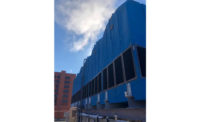Cooling towers are a critical component of many buildings’ cooling systems, as they are the points where heat is dissipated into the atmosphere through an evaporative process. They can also be a source of Legionella exposure, and water demand and waste if not properly maintained. We have seen a rapid rise in Legionella cases in North America, and water utilities are deeply interested in reducing water demand and increasing water reuse.
To address the public health and sustainability nexus found within cooling tower systems, more than 20 public agencies from across North America participated in a year-long consensus building process led by NSF’s building water health team to dramatically improve water conservation and reduce exposure to Legionella bacteria from cooling tower systems.
The public agencies participated in a series of technical webinars/trainings, which cumulated in a two-day workshop around NSF’s Legionella Conference (www.legionellaconference.org). Leveraging the insights and input of the public agencies, the Urban Sustainability Directors Network (USDN) published, “Electronic registration systems for cooling towers — Improving public health and sustainability outcomes.”
The report proposes a standardized yet flexible template for jurisdictions to create electronic registries that map cooling tower locations and potential sources of Legionnaires’ disease outbreaks, thereby improving critical response time by public health officials. In addition to pinpointing cooling tower sites, registries include maintenance records, which could help address disparity in affected populations, and increase water and energy efficiency. The report outlines the significant water conservation and water reuse opportunities that can be achieved through improved management of cooling towers.
The report was developed by NSF Health Sciences, an NSF International company, and GroveWare Technologies for the USDN. Public officials from Vancouver, Canada, which has recently adopted a cooling tower registry system, and the City of Philadelphia helped lead the effort.
Legionella can grow in poorly maintained premise plumbing and cooling tower systems. Once inhaled, aerosolized water droplets contaminated with Legionella bacteria can cause Legionnaires’ disease, an acute form of pneumonia, as well as the less severe Pontiac fever.
More than 2 million cooling towers are located in the United States in commercial, industrial, health care, hospitality and residential facilities, yet few regulations cover their operations, according to the report. In the absence of a method to track tower locations, cities are “forced to rely on imprecise methodologies during public health emergencies,” the USDN report says, adding that there is a “continued tolerance of widely divergent maintenance practices by building owners.”
Reports and records
New York City and the State of New York are the largest U.S. jurisdictions to implement an electronic cooling tower registration system. New York City created its registry after a large Legionnaires’ outbreak in 2015 sickened 138 people and led to 16 deaths, and the state applied health and safety requirements for cooling tower systems statewide soon after. Worldwide, a handful of other cities, states and provinces require cooling towers to be registered, for example Austin, Texas; Hamilton, Canada; Quebec, Canada and Victoria, Australia. National registries also exist in the United Kingdom, France, Germany, the Netherlands, Hong Kong and Singapore.
A record number of 9,933 Legionnaires’ cases were reported by the U.S. Centers for Disease Control and Prevention (CDC) for 2018, a more than eightfold increase compared to 2000. Additionally, the CDC reports 10% of community-acquired cases and 25% of those in health care settings are fatal, and that 90% of the problems that caused a Legionella outbreak could have been prevented with a properly designed and implemented water management plan.
The disease is believed to be widely underreported. In 2019, a National Academies of Sciences, Engineering and Medicine (NASEM) report estimated as many as 70,000 people per year in the United States alone may contract Legionnaires’ disease. The NASEM report recommended adoption of cooling tower registries to help prevent and rapidly respond to outbreaks.
According to a study published in April 2018 in Current Environmental Health Reports, cooling towers were implicated or suspected in the majority of Legionnaires’ disease outbreak-associated deaths examined during the study period between 2006-2017.
Registries are also an important sustainability tool that can help evaluate the effectiveness of maintenance plans and identify areas for improved efficiency, the USDN report highlights. Poor energy conservation practices increase water demand, and cooling towers can represent 20 to 50% of a building’s total water usage, according to the report, which adds that poor management practices result in millions of wasted gallons of water per year in a single cooling tower. In Los Angeles, for example, it is estimated that more than 2 billion gallons of water per year are wasted, according to the report.
Read the report with a full list of participant cities at USDN and NSF.
NSF’s building water health (BWH) team provides independent support to large building portfolio managers to develop consistent and effective risk management and conservation strategies across all their cooling tower systems and the water treatment vendors that service them.
The BWH team routinely provides trainings and workshops on cooling tower registration systems, Legionnaires’ disease outbreak response investigations and/or sustainability strategies for cooling tower systems to public agencies. For more information, contact NSF Health Sciences’ building water health team at buildingwaterhealth@nsf.org.



